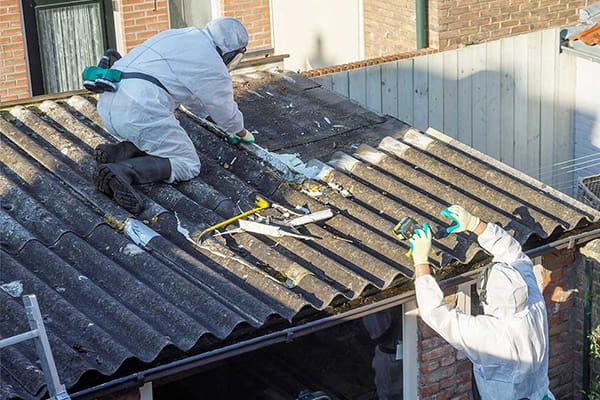Using Technology In Asbestos Roof Removal Hazardous Materials & Disposal Services
Using Technology In Asbestos Roof Removal Hazardous Materials & Disposal Services
Blog Article
Asbestos Roof Removal Health Risks Removal And Disposal Of Asbestos
Asbestos management plans are crucial tools for the safe dealing with and control of asbestos materials in various environments. With the health risks related to asbestos exposure, together with lung disease and other critical respiratory circumstances, having a comprehensive management plan is essential for any facility that may contain asbestos.
The creation of asbestos management plans involves a radical assessment of the premises where asbestos could be present. This consists of identifying the types of materials that contain asbestos and evaluating their condition. Regular inspections are needed as a result of the integrity of asbestos-containing materials can degrade over time, raising the risk of airborne asbestos fibers.

Once the assessment is carried out, the plan should include clear procedures for managing asbestos safely. This consists of guidelines on how to handle, keep, and, if essential, take away asbestos-containing materials. Proper labeling and signage are additionally essential to ensure that staff and guests are aware of areas which will pose a risk.
Environmental Impact Of Asbestos Roof Removal Best & Cheap Removal Services Available
Training and education play a big position within the profitable implementation of asbestos management plans. Employees who might come into contact with asbestos have to be educated about the hazards, safe work practices, and emergency procedures. Regular training sessions can help keep safety on the forefront of office tradition.
The management plan ought to define particular duties for staff and management. Designating an asbestos coordinator can streamline the process of monitoring, reporting, and speaking about asbestos-related issues. This individual serves as a point of contact for questions and issues regarding asbestos safety.
Documentation is a key side of asbestos management plans. Maintaining accurate information of inspections, incidents, training, and maintenance activities is important for accountability and ongoing risk assessment. This documentation can also prove invaluable in case of regulatory inspections or legal inquiries.
Safe Asbestos Roof Removal Techniques Residential Asbestos Removal Services
In addition to identifying materials and implementing safe handling practices, the plan must define response protocols for asbestos-related emergencies. Asbestos Roof Removal Licenses And Accreditation. These protocols should include measures to follow in the event of a fabric breach or suspected fiber release. Providing clear steps might help mitigate risks and guarantee swift motion
Periodic review and updating of the asbestos management plan are important to mirror any adjustments in regulations, office circumstances, or materials current. Continuous enchancment is essential to adapt to new data or technologies associated to asbestos safety. Stakeholders should be concerned in this process to guarantee that the plan remains relevant and effective.
Asbestos Roof Removal Best Contractors In Sydney Hazardous Materials & Disposal Services
Compliance with native and national regulations concerning asbestos is non-negotiable. Organizations must keep knowledgeable about relevant legal guidelines and guidelines that govern asbestos handling and disposal. This helps avoid legal penalties and enhances the overall safety tradition throughout the group.
Community awareness is one other necessary consider effective asbestos management plans. Engaging with native authorities, health agencies, and the community can foster a greater understanding of asbestos-related points. This collaboration ensures that every one parties are knowledgeable about potential risks and safety measures in place.
Asbestos management plans do not operate in isolation; they're part of a broader health and safety strategy. By prioritizing the well-being of employees and the encircling community, organizations can contribute to a safer environment. The integration of asbestos management with other safety protocols allows for a holistic method to workplace safety.
Asbestos Roof Disposal Regulations In Sydney How To Get Your Roof Replaced For Under 1000
The aim of an asbestos management plan isn't just compliance but also proactive risk management. By successfully identifying hazards and implementing mitigation methods, organizations can significantly cut back the likelihood of asbestos exposure. This dedication to safety ultimately protects each employees and the underside line.
Effective communication about the asbestos management plan is crucial for fostering a culture of safety. Clear dissemination of knowledge ensures that everyone understands the risks and the measures in place to mitigate them. Providing clear reporting channels encourages employees to voice considerations and contribute to safety efforts.
Finally, the importance of periodic monitoring can't be overstated. Regular audits of the asbestos management plan help identify areas for enchancment and verify that safety measures are adopted. Continuous analysis creates a feedback loop, selling a safer working environment.
In summary, asbestos management plans serve as essential frameworks for controlling and managing the risks associated with asbestos exposure. Through thorough assessment, effective communication, ongoing training, and common updates, organizations can create safe environments for his or her employees and the community. The focus ought to always be on proactive measures, compliance with regulations, and a robust safety tradition.
Asbestos Risk Mitigation During Roofing Projects Cost Guide For Asbestos Removal
By making certain that every aspect of the plan is well-executed, organizations can significantly decrease the risks tied to asbestos materials. This ongoing dedication to safety will not only protect individuals but additionally improve organizational reputation and trust.
Continuous adaptation and refinement of asbestos management plans will finally result in a more knowledgeable workforce that prioritizes safety above all. Such a tradition is crucial for achieving long-term safety objectives and guaranteeing the health of all stakeholders concerned.
Asbestos Roofing Material Identification Removal And Disposal Of Asbestos
Ultimately, the well-being of workers and the environment ought to guide the development and implementation of any asbestos management technique. By remaining vigilant and diligent of their approach, organizations can navigate the complexities of asbestos management effectively.
In conclusion, the roadmap for asbestos safety is challenging but important. A carefully crafted and executed asbestos management plan, complete with thorough assessments, communication protocols, and ongoing schooling, lays the groundwork for a secure and compliant office. This proactive approach fosters a protective environment for all those involved, solidifying the commitment to safety for the longer term.
- Asbestos management plans define protocols for identification, assessment, and management of asbestos-containing materials in varied settings, significantly in buildings.
- Regular inspections and risk assessments are important parts of an asbestos management plan, ensuring ongoing monitoring and updated information regarding potential hazards.
- Training for personnel on asbestos awareness and safety measures is essential, ensuring that workers are knowledgeable in regards to the risks and procedures associated to asbestos exposure.
- Development and maintenance of a list of asbestos areas, sorts, and situations enable for knowledgeable decision-making when planning renovations or demolitions.
- Emergency response procedures tailor-made for asbestos-related incidents help reduce health risks during unexpected situations involving asbestos disturbance.
- Effective communication methods inside a company inform all stakeholders of asbestos management plans, highlighting duties and encouraging a tradition of safety.
- Documentation of all asbestos-related activities, including removal, encapsulation, or repair, is necessary for compliance with regulatory standards and for future reference.
- Stakeholder engagement, together with occupants and neighboring properties, is important to boost awareness and tackle concerns regarding asbestos management and safety practices.
- Integrating asbestos management plans with total health and safety insurance policies can create a cohesive strategy to workplace safety and environmental health.
- Regular evaluations and updates of the asbestos management plan guarantee relevance and effectiveness, adapting to any modifications in regulations, building occupancy, or material condition.undefinedWhat are asbestos management plans?
Community Support For Asbestos Affected Areas Removal & Replacement Of Roof Asbestos

Asbestos management plans are documents that define the means to manage asbestos on a property. They detail the location, situation, and kinds of asbestos-containing materials, along with methods for safe monitoring, maintenance, and mitigation.
Why do I need an asbestos management plan?
An asbestos management plan is essential for shielding health and safety. It ensures that each one potential asbestos hazards are recognized and managed appropriately, minimizing the danger of exposure to people on the property.
Sydney Asbestos Roof Removal Contractors Best & Cheap Removal Services Available
Who is liable for creating an asbestos management plan?
Typically, the property owner or employer is liable for developing and implementing an asbestos management plan. It is commonly beneficial to seek the advice of with certified professionals or licensed asbestos surveyors to ensure compliance with regulations.

How often ought to my asbestos management plan be reviewed? Asbestos Roof Removal Timelines And Schedules.
Impact Of Weather On Asbestos Roof Removal Hazardous Materials & Disposal Services
Asbestos management plans must be reviewed a minimum of every 12 months or each time significant modifications occur on the property, similar to renovations or harm to areas containing asbestos. This ensures that the plan remains up-to-date and effective.
What ought to I do if my asbestos management plan identifies risks?
If risks are identified, quick motion should be taken based on the plan. This could include repair, encapsulation, or removal of asbestos materials by licensed professionals, together with notifying affected individuals concerning the risks and safety measures.
Can I manage asbestos points myself without a plan?
Asbestos Roof Removal Health Risks Safe, Reliable And Experienced Removal Services
It just isn't advisable to manage asbestos issues without a formal plan. Improper dealing with can lead to critical health risks and legal consequences. Consulting a certified professional is essential for safety and compliance with regulations.
How do I find a certified professional for my asbestos management plan?
To discover a certified professional, look for licensed asbestos consultants or surveyors in your area. It is essential to envision their certifications, expertise, and reviews to ensure they meet regulatory requirements and have a great observe report of safety.
Public Health Implications Of Asbestos Exposure Find A Licensed Asbestos Removalist
What happens if I don’t have an asbestos management plan?
Lack of an asbestos management plan can lead to non-compliance with native regulations, leading to heavy fines, legal liability, and elevated health risks for occupants. It is crucial to have an efficient plan in place to administer asbestos safely.
Is training required for these dealing with asbestos management plans?
Yes, people concerned in managing asbestos ought to obtain acceptable training. This contains understanding the risks, the specifics of the management plan, and safe work practices. Regular training ensures everybody is ready to reply to potential asbestos points successfully.
review website link Report this page